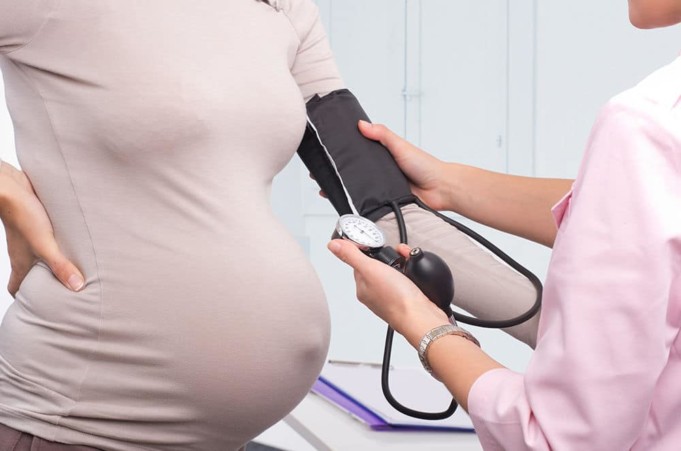According to the Preeclampsia Foundation, 5-8% of all pregnancies are going to present preeclampsia as a complication. This condition is something all women should be aware of during their pregnancies as it can become life-threatening if no treatment measures are taken. Preeclampsia refers to the dangerous rising of the mother’s blood pressure, with negative effects for both the mother and the fetus. Medical attention is a must, in order to ensure a healthy pregnancy and a safe delivery of the baby.

Preeclampsia, a potentially fatal complication of pregnancy
The condition appears in the second half of the pregnancy, usually after 20 weeks. Apart from the high blood pressure, women will also present high levels of protein in the urine. What happens is that many blood vessels suffer from constriction, which will cause the blood pressure to rise. This does not normally happen in a healthy pregnancy, and it can lead to further complications, such as pre-term delivery, low birth weight for the baby and even placental abruption.
What are the causes of preeclampsia?
Despite the extensive research in the field, the exact causes that lead to the appearance of preeclampsia have yet to be identified. The theory that has received the highest amount of support is the one involving prostaglandins. These substances are involved in the contraction and relaxation of the smooth muscles during a woman’s pregnancy. In women who are diagnosed with preeclampsia, the prostaglandins suffer from imbalance.
What happens if preeclampsia is not treated?
If the condition does not receive immediate medical attention, it is possible that the placenta will separate from the uterus, threatening the life of both mother and baby. Moreover, other serious complications can occur, such as seizures, stroke, and even kidney failure. The mother can suffer from transient or permanent loss of vision, liver rupture and, in rare cases, maternal or fetal death can occur.
Are all women at risk for preeclampsia?
Even though there are certain risk factors to consider, not all women will develop this condition. However, it is important to understand that the complication can occur all of a sudden, causing both the blood pressure and the urine protein levels to rise. As for the actual risk factors, these include the family history of preeclampsia, primary pregnancy, being too young/old (as a mother), twins/triplets, high blood pressure, obesity, and diabetes.
Symptoms of preeclampsia
image credit: wikihow
Apart from the rising blood pressure and urine protein, the mother might experience edema (accumulation of excess fluid) at the level of the face and hands. Rapid weight gain can also appear, as well as severe headaches, visual impairment, and abdominal pain. The mother-to-be can experience nausea, vomiting and breathing difficulties. She may also become confused or suffer from anxiety.
Diagnose and treatment
The diagnosis of preeclampsia is made by measuring the mother’s blood pressure level, as well as the level of protein in the blood. Also, the doctor might use the physical symptoms presented by the mother, in order to confirm the diagnosis. Unfortunately, there is no cure for treating preeclampsia, other than delivering the baby. The mother is immediately placed on bed rest, being recommended to avoid excessive stimulation and both her and the baby being monitored. Steroid treatments might help the baby to continue developing until the delivery occurs.
May, Preeclampsia Awareness Month
In an effort to raise awareness about the complications of pregnancy, such as preeclampsia, Preeclampsia Foundation has declared the month of May to be Preeclampsia Awareness Month. During this month, there will be a lot of events organized, meant to draw attention to the potentially life-threatening complication of pregnancy. The theme for this year is “The Faces of Preeclampsia: Any Woman, Any Pregnancy.” As more women share their stories about having dealt with preeclampsia, other women will discover the courage to speak out in the open and share their experiences.
It is highly important to understand that the mother might experience a high blood pressure, even after the delivery. In the initial period after the birth, she will have to be closely monitored, in order to ensure she maintains a good status of health and no complications occur. It is also worth mentioning that women who have experienced preeclampsia during the pregnancy present a higher risk of postpartum depression.
Conclusion
All women should be aware of the complications that occur during pregnancy, especially when it comes to those that are potentially fatal, such as preeclampsia. This is even more essential for women who have a family history of such complications.
Must watch this video: 1 & 2 Weeks Pregnant: What You Really Need to Know.
Author Bio:
Margaux Diaz is Health and Fitness Expert. She has completed her Master’s Degrees in Biotechnology from the University of Southern California. She is an inspirational writer who firmly believes in the power of self-motivation. She is a contributor to Consumer Health Digest since Five years. To get more tips regarding health and fitness connect with her on Facebook, Twitter and Google+












